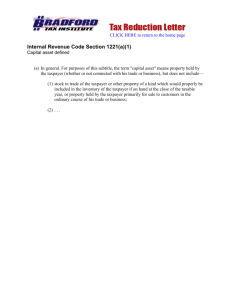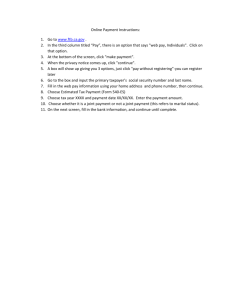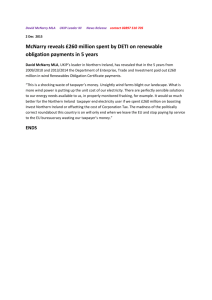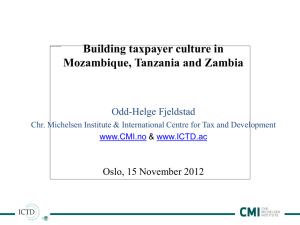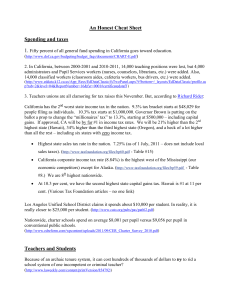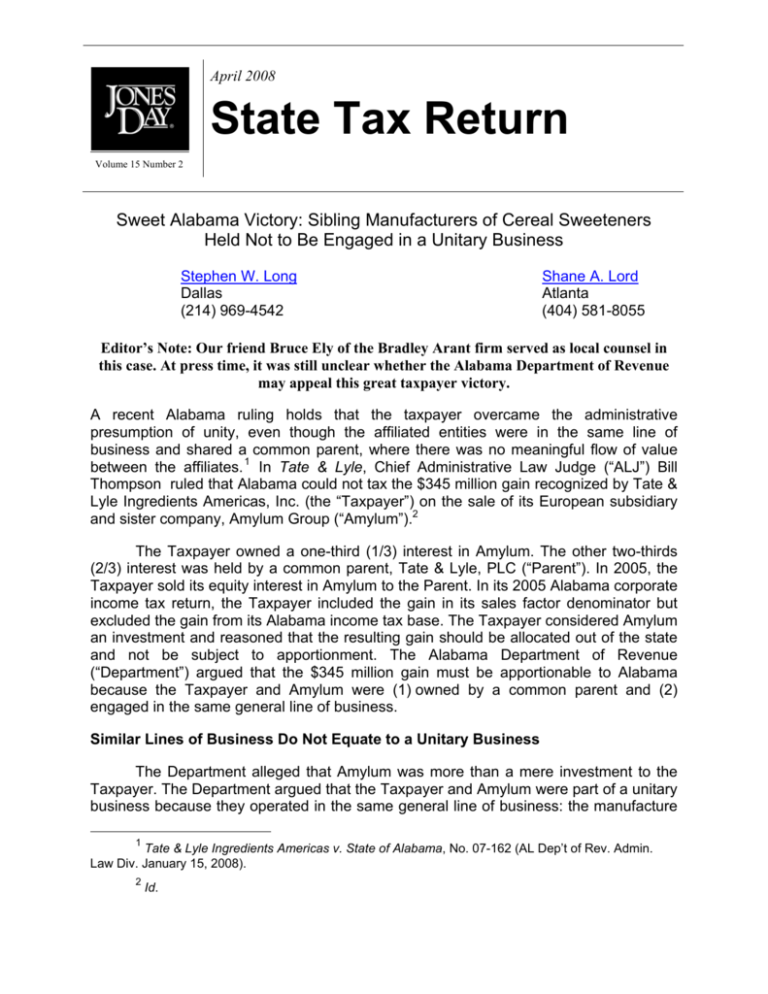
April 2008
State Tax Return
Volume 15 Number 2
Sweet Alabama Victory: Sibling Manufacturers of Cereal Sweeteners
Held Not to Be Engaged in a Unitary Business
Stephen W. Long
Dallas
(214) 969-4542
Shane A. Lord
Atlanta
(404) 581-8055
Editor’s Note: Our friend Bruce Ely of the Bradley Arant firm served as local counsel in
this case. At press time, it was still unclear whether the Alabama Department of Revenue
may appeal this great taxpayer victory.
A recent Alabama ruling holds that the taxpayer overcame the administrative
presumption of unity, even though the affiliated entities were in the same line of
business and shared a common parent, where there was no meaningful flow of value
between the affiliates. 1 In Tate & Lyle, Chief Administrative Law Judge (“ALJ”) Bill
Thompson ruled that Alabama could not tax the $345 million gain recognized by Tate &
Lyle Ingredients Americas, Inc. (the “Taxpayer”) on the sale of its European subsidiary
and sister company, Amylum Group (“Amylum”).2
The Taxpayer owned a one-third (1/3) interest in Amylum. The other two-thirds
(2/3) interest was held by a common parent, Tate & Lyle, PLC (“Parent”). In 2005, the
Taxpayer sold its equity interest in Amylum to the Parent. In its 2005 Alabama corporate
income tax return, the Taxpayer included the gain in its sales factor denominator but
excluded the gain from its Alabama income tax base. The Taxpayer considered Amylum
an investment and reasoned that the resulting gain should be allocated out of the state
and not be subject to apportionment. The Alabama Department of Revenue
(“Department”) argued that the $345 million gain must be apportionable to Alabama
because the Taxpayer and Amylum were (1) owned by a common parent and (2)
engaged in the same general line of business.
Similar Lines of Business Do Not Equate to a Unitary Business
The Department alleged that Amylum was more than a mere investment to the
Taxpayer. The Department argued that the Taxpayer and Amylum were part of a unitary
business because they operated in the same general line of business: the manufacture
1
Tate & Lyle Ingredients Americas v. State of Alabama, No. 07-162 (AL Dep’t of Rev. Admin.
Law Div. January 15, 2008).
2
Id.
©Jones Day 2008
of cereal sweeteners (i.e., that the only discernable difference in the business models of
the two companies was that the Taxpayer marketed and sold corn-based sweeteners to
companies in the U.S., whereas Amylum marketed and sold wheat-based sweeteners
to companies in Europe).
While there is an administrative presumption in Alabama and other jurisdictions
that commonly owned companies are unitary if they engage in the same line of
business, this presumption is rebuttable. As the Supreme Court of the United States
established in Container Corp., there must be a flow of value before there can be a
constitutionally acceptable unitary finding.3 Merely being in the same line of business as
a subsidiary or sibling corporation by itself does not meet this test.
The Taxpayer rebutted the unitary presumption by persuading the ALJ that there
was no flow of value between the Taxpayer and Amylum from the factors of profitability
as provided by the United Supreme Court in Mobil Oil: (1) functional integration, (2)
centralized management, and (3) economies of scale.4
In Tate & Lyle, there was no functional integration between the Taxpayer and
Amylum. The day-to-day operations of the two companies were totally unrelated. Each
company independently manufactured, marketed, and sold its products to customers on
different continents. Each company had its own manufacturing facilities and separate
administrative departments such as accounting, payroll, and legal. There was no
sharing of raw materials or employees. Also, the companies purchased only a small
amount of finished product from each other, and when they did so–it was at arm’slength prices.
There was no centralization of management between the companies. They had
independent management teams that made all operating decisions and “were in no way
involved with the management of the other.” The companies also had no common
directors on their respective boards.
There were also no meaningful economies of scale. While both companies did
purchase supplies pursuant to a global purchasing agreement arranged by their
common parent, the ALJ ruled that this alone was not sufficient evidence to prove a
unitary relationship. Rather, the ALJ found the agreement to be merely evidence that
the two companies shared a common parent. As a result, the Taxpayer met its burden
and rebutted the presumption that it and Amylum must be unitary because they were in
the same general line of business.
A Unitary Finding Requires Actual Control By the Parent Corporation
The Department also alleged that the Taxpayer and Amylum were necessarily
unitary because they shared a common parent. Of course, the Supreme Court in F.W.
Woolworth Co. took a contrary position when it held that wholly owned subsidiaries are
3
4
Container Corp. v. Franchise Tax Board, 463 U.S. 159, 178-79 (1983).
Mobil Oil Corp. v. Commissioner of Taxes of Vermont, 445 U.S. 425 (1980).
©Jones Day 2008
not unitary with a parent if the parent does not exercise control over the subsidiaries.5
The Supreme Court distinguished the corporate stewardship found in Woolworth from
the active control exhibited in a unitary business by holding that “[e]xcept for the type of
occasional oversight—with respect to capital structure, major debt, and dividends—that
any parent gives to an investment in a subsidiary, there is little or no integration of the
business activities or centralization of the management of these five corporations.”6
Citing ASARCO Inc., the ALJ recognized the actual control requirement and
found that evidence of actual control was lacking.7 The Parent did not share common
directors with either the Taxpayer or Amylum. More importantly, the Parent did not
involve itself in the management of either company. There was some occasional
discussion of business between the Parent and the subsidiaries, but there was nothing
that exceeded the permissible bounds of stewardship established in Woolworth.
Therefore, the common ownership of the Taxpayer and Amylum was insufficient to merit
a unitary finding.
Long-Term Investments Do Not Serve an Operational Function
The Taxpayer’s long-term investment in Amylum did not serve an operational
function. The operational function test was announced by the Supreme Court in AlliedSignal.8 This test focuses on “the objective characteristics of the asset’s use and its
relation to the taxpayer and its activities within the taxing State.”9 In particular, it allows
states to apportion income earned outside of their borders—provided the incomeproducing asset performs an operational function in an in-state business.
In Allied-Signal, the Court gave two examples of income meeting the operational
function test: (1) out-of-state bank accounts used to hold short-term working capital and
(2) hedging transactions.10 The ALJ in Tate & Lyle found that the Taxpayer’s interest in
Amylum did not resemble either example. The Taxpayer’s interest in Amylum was not
similar to a short-term deposit of capital because the interest had been held for 45 years.
In addition, no evidence was presented that suggested the purchase of Amylum
constituted a hedging transaction. As a result, the purchase of Amylum stock by
Taxpayer was an investment that served no operational function in Taxpayer’s business
anywhere.
5
6
7
8
9
F.W. Woolworth Co. v. Taxation and Revenue Dep’t, 458 U.S. 354, 362 (1982).
Id. at 369.
ASARCO Inc. v. Idaho State Tax Comm’n, 458 U.S. 307 (1982).
Allied-Signal, Inc. v. Dir., Div. of Tax’n, 504 U.S. 768, 785 (1992).
Id.
10
Id. at 788.
©Jones Day 2008
Use of Proceeds is Not a Relevant Inquiry
In dicta, the ALJ addressed testimony by the Taxpayer’s general counsel that
proceeds from the sale of Amylum were going to be used to expand the Taxpayer’s
business. Relying on Allied-Signal, the ALJ recognized that future use of proceeds from
the sale cannot change the characterization of the Taxpayer’s interest in Amylum. The
ALJ ruled that “the operationally-related test focuses on whether the asset that resulted
in the income was used in a taxpayer’s business before the income was realized, not
how the income, once realized, may later be used.” Because the Taxpayer purchased
and held the Amylum stock as an investment, the resulting gain could not be
apportioned, irrespective of how the proceeds were later spent. As a result, it was held
that the income earned from the stock sale was not apportionable to Alabama.
Conclusion
In Tate & Lyle, the ALJ reached a result firmly grounded in and supported by
United States Supreme Court precedent. The Commerce Clause does not require
commonly owned companies to engage in distinct lines of business in order to be held
not unitary. The Tate & Lyle decision properly recognizes that the “flow of value” is the
proper measure when making a unitary business determination.
The United States Supreme Court is currently revisiting the unitary business
concept in MeadWestvaco Corp. v. Illinois Dep’t of Revenue.11 While it is unclear how
MeadWestvaco will reshape unitary business jurisprudence, Tate & Lyle provides a
sound interpretation of its current state.■
This article is reprinted from the State Tax Return, a Jones Day monthly newsletter reporting on
recent developments in state and local tax. Requests for a subscription to the State Tax Return or
permission to reproduce this publication, in whole or in part, or comments and suggestions should be
sent to Teresa M. Barrett-Tipton (214.969.5186) in Jones Day’s Dallas Office, 2727 N. Harwood,
Dallas, Texas 75201 or StateTaxReturn@jonesday.com.
©Jones Day 2008. All Rights Reserved. No portion of the article may be reproduced or used without express
permission. Because of its generality, the information contained herein should not be construed as legal advice on
any specific facts and circumstances. The contents are intended for general information purposes only.
11
MeadWestvaco Corp. v. Illinois Dep’t of Revenue, 861 N.E.2d 1131 (Ill. App. 2007), cert.
granted, 128 S.Ct. 29 (U.S.Ill. Sept. 25, 2007).

